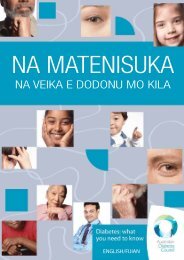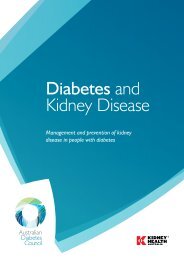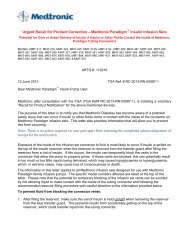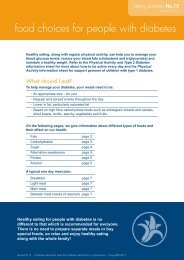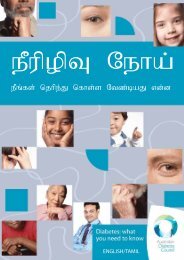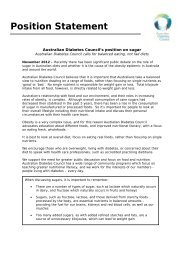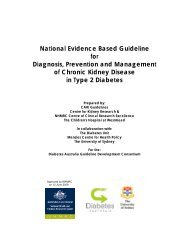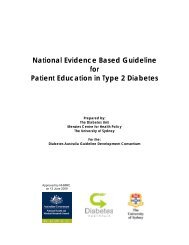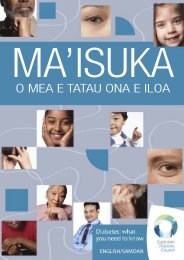Part 6: Detection and Prevention of Foot Problems in Type 2 Diabetes
Part 6: Detection and Prevention of Foot Problems in Type 2 Diabetes
Part 6: Detection and Prevention of Foot Problems in Type 2 Diabetes
You also want an ePaper? Increase the reach of your titles
YUMPU automatically turns print PDFs into web optimized ePapers that Google loves.
Background - Frequency <strong>of</strong> <strong>Foot</strong> Exam<strong>in</strong>ationWhile people with diabetes who have peripheral neuropathy, foot deformity, history<strong>of</strong> previous ulceration or amputation <strong>and</strong>/or PVD are a group at <strong>in</strong>creased risk <strong>of</strong>ulceration <strong>and</strong> amputation, no studies have been done to assess the impact <strong>of</strong> thefrequency <strong>of</strong> exam<strong>in</strong>ation on outcomes. It is generally accepted that regularsurveillance for foot problems is good cl<strong>in</strong>ical practice. The benefits <strong>of</strong> monitor<strong>in</strong>gpeople with diabetes arise from the ability to detect feet at <strong>in</strong>creased risk <strong>and</strong> from theidentification <strong>of</strong> specific foot problems which can be treated early which has thepotential to reduce subsequent morbidity.Evidence – Frequency <strong>of</strong> <strong>Foot</strong> Exam<strong>in</strong>ationRout<strong>in</strong>e exam<strong>in</strong>ation <strong>of</strong> the feet <strong>of</strong> people with diabetes is frequently notperformedThe lack <strong>of</strong> rout<strong>in</strong>e foot exam<strong>in</strong>ation is a major issue <strong>in</strong> the care <strong>of</strong> people withdiabetes. A UK retropective survey (Deerochanawong et al, 1992) showed that 47%<strong>of</strong> people who were under the care <strong>of</strong> a hospital service for diabetes had <strong>in</strong>completefoot exam<strong>in</strong>ation <strong>and</strong> assessment. 15% <strong>of</strong> people with diabetes had their diabetes firstdiagnosed when they were admitted for amputation.In a New Zeal<strong>and</strong> survey <strong>of</strong> 540 people with diabetes (Simmons et al, 1995), majorlesions (amputation, ulcer) <strong>and</strong> perdispos<strong>in</strong>g lesions (callus or fugual <strong>in</strong>fection) werepresent <strong>in</strong> 48.5% <strong>of</strong> people. However, 40% <strong>of</strong> people (n=214) reported they had nothad their feet exam<strong>in</strong>ed over the previous 12 months.Wylie-Rosett et al (1995) reviewed foot exam<strong>in</strong>ation <strong>in</strong> 350 people with diabetes(86% were black or Hispanic, mean age 57.7 years). A documented foot exam<strong>in</strong>ationwas def<strong>in</strong>ed as assess<strong>in</strong>g at least two <strong>of</strong> the three components (circulation, sk<strong>in</strong> <strong>and</strong>neurological status) <strong>of</strong> a foot exam<strong>in</strong>ation. People had a mean duration <strong>of</strong> diabetes <strong>of</strong>8.8 years, but there was no <strong>in</strong>dication <strong>of</strong> foot exam<strong>in</strong>ation or referral for footexam<strong>in</strong>ation for 56% <strong>of</strong> people <strong>in</strong> their primary care cl<strong>in</strong>ics dur<strong>in</strong>g a 2-year period.The optimal frequency <strong>of</strong> foot exam<strong>in</strong>ation has not been established but there isgeneral <strong>in</strong>ternational consensusAlthough regular foot exam<strong>in</strong>ation is considered necessary <strong>in</strong> all people with diabetes,no studies were found which directly addressed the optimal frequency <strong>of</strong> footexam<strong>in</strong>ation <strong>in</strong> people with diabetes. However recommendations about the frequency<strong>of</strong> foot exam<strong>in</strong>ation have been made <strong>in</strong> several guidel<strong>in</strong>es <strong>in</strong> Australia <strong>and</strong> overseas.The Australian guidel<strong>in</strong>es <strong>in</strong>clude:• the New South Wales Department <strong>of</strong> Health ‘Guidel<strong>in</strong>es for the Cl<strong>in</strong>icalManagement <strong>of</strong> <strong>Diabetes</strong> Mellitus’ (1996) which suggests six monthly foot review<strong>of</strong> people with diabetes or at every visit for people <strong>in</strong> the “high risk foot” category• the ‘Systematic Review <strong>of</strong> Exist<strong>in</strong>g Evidence <strong>and</strong> Primary Care Guidel<strong>in</strong>es on theManagement <strong>of</strong> Non-Insul<strong>in</strong>-Dependent <strong>Diabetes</strong> <strong>in</strong> Aborig<strong>in</strong>al <strong>and</strong> Torres StraitIsl<strong>and</strong>er Populations’ (Couzos et al, 1998) proposes that feet should be <strong>in</strong>spected54



